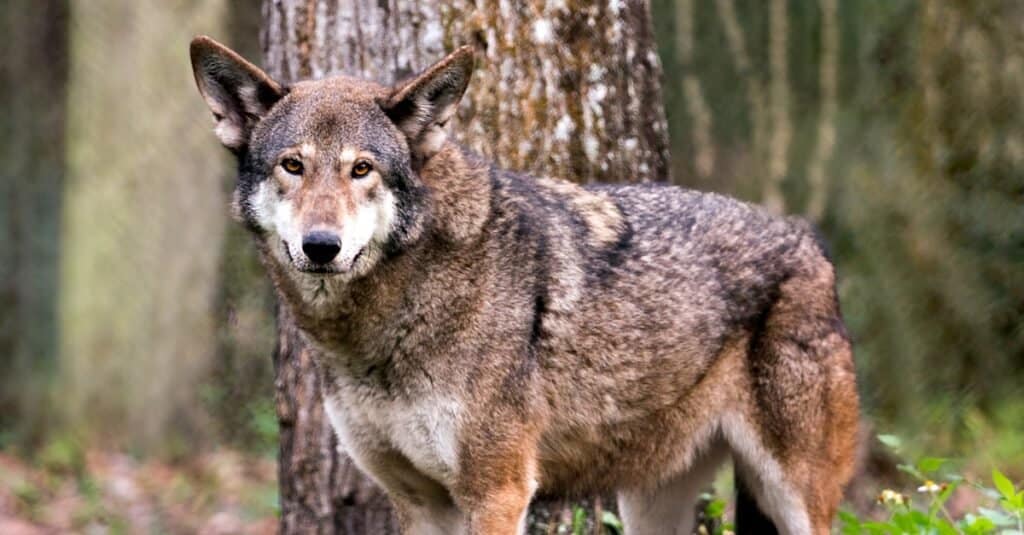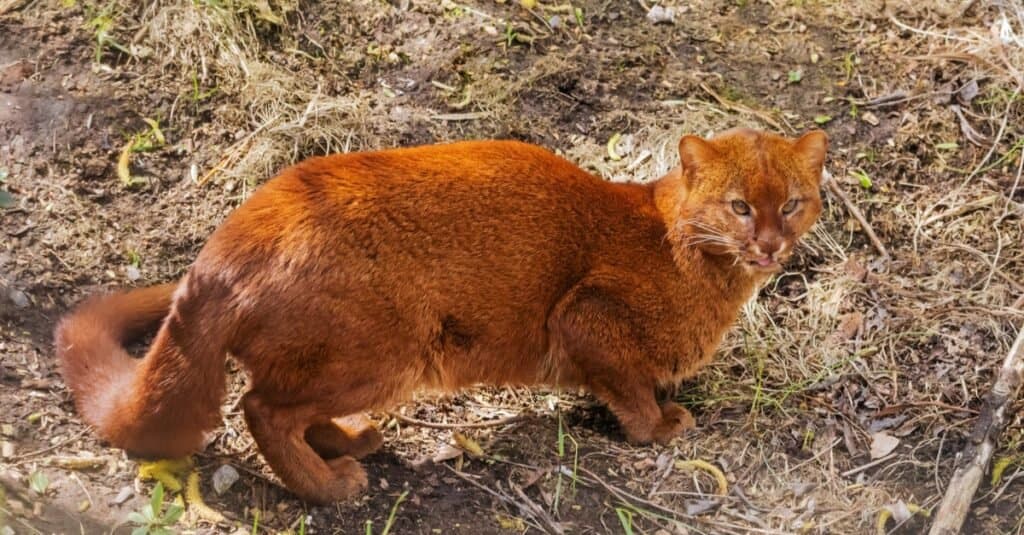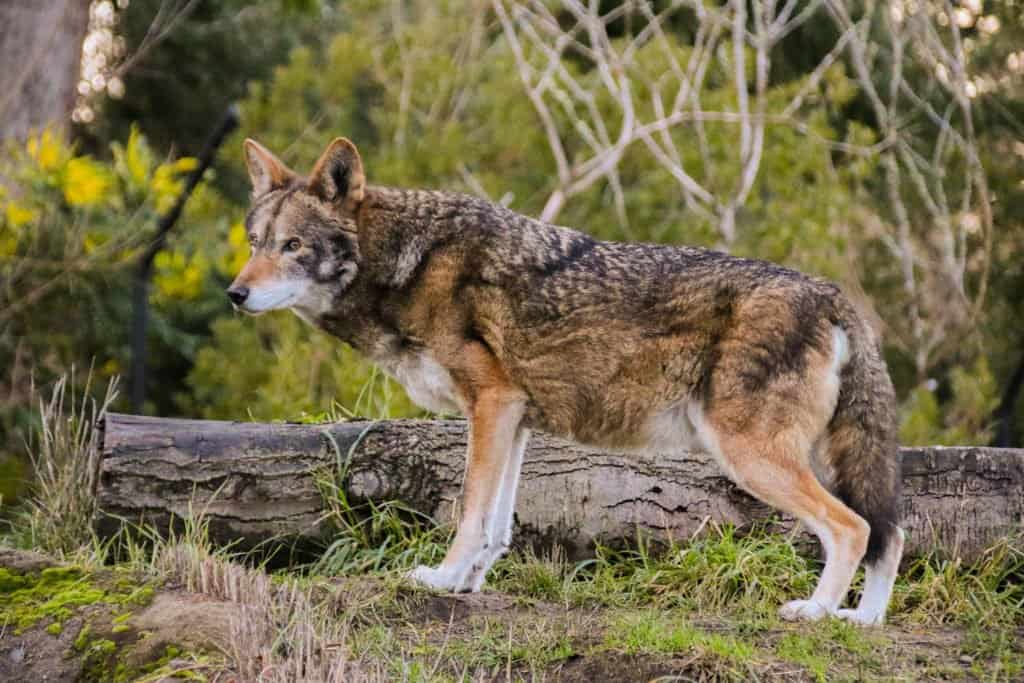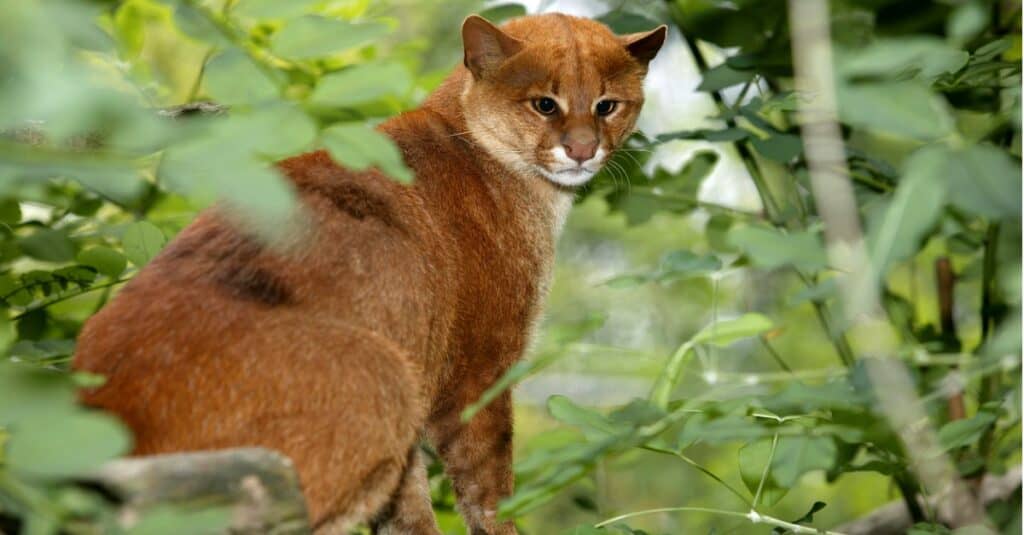Jaguarundis and red wolves are both members of the order Carnivora. However, they belong to different families. The jaguarundi is a medium-sized wild cat native to Central and South America. The red wolf is one of the world’s most endangered canids. It’s native to the southeastern United States. Both species thrive in almost the same habitat, which is why the two are often mistaken for one another. They are also characterized by vibrant colors, which can be easily confused from a distance.
So, how can we distinguish these two animals? First, jaguarundis are typically solitary animals, and although they are usually terrestrial, they are capable of climbing trees. In contrast, red wolves are social animals who can’t climb trees but can only reach lower branches by jumping or standing on their hind legs. Join us as we discover the key differences between a jaguarundi and a red wolf!
Comparing Jaguarundi vs Red Wolf
| Jaguarundi | Red Wolf | |
|---|---|---|
| Scientific Classification | Kingdom- Animalia Phylum- Chordata Class- Mammalia Order- Carnivora Family- Felidae Subfamily – Felinae Genus- Herpailurus Species- Herpailurus yagouaroundi | Kingdom- Animalia Phylum- Chordata Class- Mammalia Order- Carnivora Family- Canidae Genus- Canis Species- Canis rufus |
| Size | – Body length- 21 to 30 inches (53 and 76 cm) – Tail length – 12 to 20 inches (30 to 51 cm) – Height at the shoulder – 14 in (36 cm) – Weight- 7.7 to 15.4 pounds (3.5 to 7 kg) | – Length – 53.5 – 63 in (136 to 160 cm) – Height at the shoulder – 26 inches (66 cm) – Weight- 45 to 80 pounds (20.4 to 36 kg) |
| Color | Red, brown, gray, black | Reddish, black, may have white patches, brown, gray |
| Diet | Eat fish, rodents, and rabbits | Eat raccoons, white-tailed deer, rabbits, mice, and many other rodents |
| Distribution and Habitat | – Primarily found in Central and South America – Inhabit woodland, savannah, swamp, and scrubland | – On North Carolina’s Albemarle Peninsula in the wild; in US breeding facilities in captivity – Prefer coastal prairies and marshlands, but can live in forests and brushlands |
| Behavior | Solitary | Social |
| Reproduction and Lifespan | – The mating season takes place any time of the year – The gestation period is 70 to 75 days – Give birth to approximately one to four babies – Have a lifespan of up to 15 years | – Mating season usually occurs from January to March – The gestation period is eight to nine weeks – Litter capacity of two to ten pups – 6 – 7 years in the wild; 10 – 12 in captivity |
| Conservation Status | Least Concern | Critically Endangered |
The Key Differences Between Jaguarundi and Red Wolf
Although they have a lot in common, jaguarundis and red wolves are different animals. At first glance, it’s fairly obvious that they don’t look the same. There are several key differences that make it much easier to tell the two animals apart, which include size, appearance, diet, habitat, behavior, and lifespan, among others.
The jaguarundi is a slender, medium-sized cat from the Felidae family. Among felids, the jaguarundi closely resembles the flat-headed cat. The red wolf’s appearance is representative of the family Canidae and is predominantly intermediate in size between the gray wolf and the coyote.
Let’s discuss their differences in detail below!
Jaguarundi vs Red Wolf: Scientific Classification

The red wolf belongs to the
Canidaefamily.
©Rejean Bedard/Shutterstock.com
Jaguarundis belong to the Felidae family. Its scientific name is Herpailurus yagouaroundi. Jaguarundi is derived from a Guarani word since Guarani is spoken in Paraguay, where this feline is found.
The red wolf belongs to the Canidae family. Its scientific name is Canis rufus. Canis rufus means “red dog.” Canis is the common genus for several animals, including dogs, jackals, coyotes, and wolves.
Jaguarundi vs Red Wolf: Size

An adult jaguarundi stands between 21 and 30 inches.
©Ian Duffield/Shutterstock.com
Jaguarundis are smaller than red wolves. An adult jaguarundi stands between 21 and 30 inches (53 and 76 cm) long (head and body) and weighs approximately 7.7 to 15.4 pounds (3.5 to 7 kg), though larger individuals weighing 19.8 pounds (9 kg) have been reported. Their tails measure 12 to 20 inches (30 to 51 cm). On the other hand, a full-grown red wolf is 53.5 – 63 in (136 to 160 cm) long and 26 inches (66 cm) high. It weighs about 45 to 80 pounds (20.4 to 36 kg).
Jaguarundi vs Red Wolf: Color
Jaguarundi’s coat is uniformly colored with two color morphs; red (foxy red to chestnut) and gray (blackish to brownish-gray). Blackish brown individuals are often mistaken for tayras, but you can distinguish the latter by the clear, yellowish patch on the throat. Juveniles have black and white marks on the snout and lips, similar to those of a cougar. Adults have few faint markings on their faces and their belly.
Unlike jaguarundis, red wolves typically have black, tawny, or grayish fur mixed with red shades and light markings around the lips and eyes. Their chests and legs are typically red or tan and creamy white. They have a black-tipped bushy tail.
Jaguarundi vs Red Wolf: Diet

The diet of a red wolf mainly consists of raccoons, white-tail deer, and other small animals.
©Joanna Wu/Shutterstock.com
Both animals are predominantly carnivores, though red wolves sometimes tend to be omnivorous. Jaguarundis typically feed on small-sized animals. Rodents, birds, and reptiles are their primary food sources. Other animals in their diet include fish, rabbits, and frogs.
The diet of a red wolf mainly consists of raccoons, white-tail deer, and other small animals like rodents and rabbits. It consumes 2 to 5 pounds of food daily and as far as 20 miles within its territory to find prey.
Jaguarundi vs Red Wolf: Distribution and Habitat
Jaguarundis are found in the Americas. Their range extends from central Argentina in the south to northern Mexico. They inhabit various environments, from deserts and thorn scrubs to tropical rainforests and deciduous forests. They can also be found in savannas, mangroves, and cloud forests.
Red wolves can thrive in various habitats, from coastal prairie marshes and swamps to bottom-land river forests and extensive agricultural fields. Historically, they were mainly found in the southeastern United States. However, the only place they can be found today in the wild is in North Carolina.
Jaguarundi vs Red Wolf: Behavior
Jaguarundis are very shy and reclusive animals. They spend most of their time alone or in pairs. They often form pairs between individuals of opposite sexes during mating season or between mothers and older kittens.
As opposed to jaguarundis, red wolves are relatively social animals. They live in packs consisting of breeding males and females and their pups. They don’t mind including a second male in the group. Red wolves sometimes hunt in packs.
Jaguarundi vs Red Wolf: Reproduction and Lifespan

Jaguarundis have a lifespan of up to 15 years.
©slowmotiongli/Shutterstock.com
Jaguarundis mate all year round. After a gestation period of approximately 70 to 75 days, the female gives birth to one to four kittens. The mother begins to feed the kittens solid food when they are around three weeks old. They become sexually mature at one to three years of age. Jaguarundis have a lifespan of up to 15 years.
Red wolves have been observed mating between January and March. The gestation period lasts about eight to nine weeks, and females give birth to about two to six pups on average, having a maximum litter capacity of 10 puppies. Young ones reach full size in one year and become sexually mature at three years. Red wolves live for 6 – 7 years in the wild and approximately 10 to 12 years in captivity.
Jaguarundi vs Red Wolf: Conservation Status
Jaguarundis have the lowest conservation priority ranking. Since 2002, the jaguarundi has been listed as Least Concern on the IUCN Red List. However, their population is suffering a decline due to habitat loss and persecution for killing poultry.
On the other hand, in 1996, red wolves were listed by the IUCN as Critically Endangered due to the critically small population number. Red wolves were declared extinct in the wild in 1980 but were reintroduced into eastern North Carolina in 1987. Two of the three subspecies, the Florida black wolf and the Mississippi Valley red wolf, are now extinct.
Up Next:
- Red Wolf vs Coyote: What Are the Differences? – AZ Animals
- See Incredible Up Close Footage of A Wolf in Yellowstone – AZ Animals
- Wolf Lifespan: How Long Do Wolves Live? – AZ Animals
The photo featured at the top of this post is ©
Sources
Thank you for reading! Have some feedback for us? Contact the AZ Animals editorial team.







